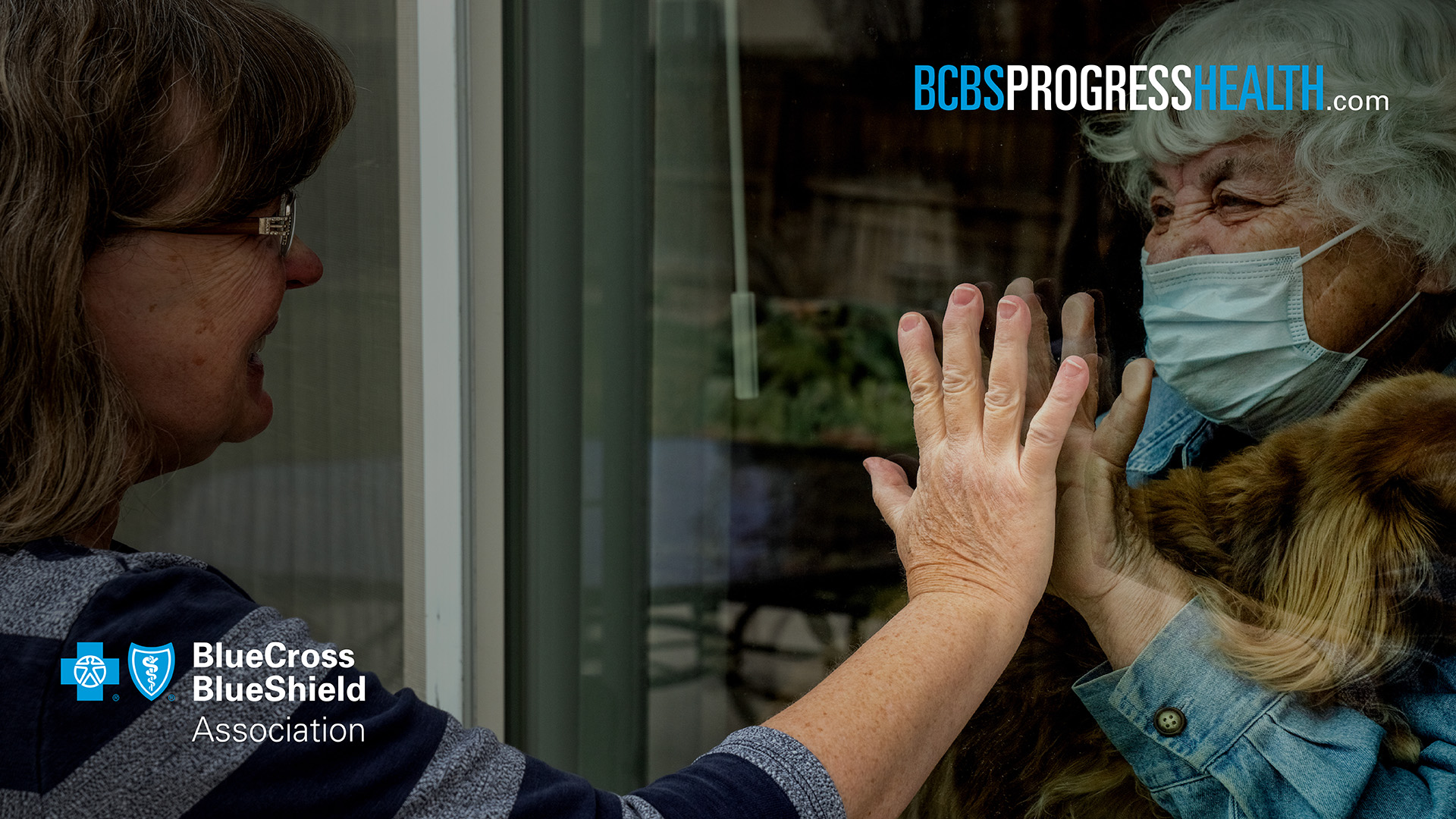| | | | | | | Presented By Blue Cross Blue Shield Association | | | | Vitals | | By Caitlin Owens ·Feb 18, 2021 | | Good morning. Situational awareness: President Biden plans to nominate Chiquita Brooks-LaSure to lead the Centers for Medicare and Medicaid Services, the Washington Post reports. - Brooks-LaSure worked at CMS under the Obama administration, where she helped implement the Affordable Care Act. Most recently, she worked as a managing director at consulting firm Manatt Health.
Today's word count is 1,005, or a 4-minute read. | | | | | | 1 big thing: Coronavirus cases fall in 44 states |  Data: The COVID Tracking Project, state health departments; Map: Andrew Witherspoon/Axios The pace of new coronavirus infections continued to plummet over the past week, despite upticks in the already hard-hit Dakotas, Axios' Sam Baker and Andrew Witherspoon report. Why it matters: This sustained drop in new cases is unambiguously good news. If the U.S. can keep it going, this progress will save lives, make it easier to safely reopen schools and businesses, and help minimize the threat posed by more contagious variants of COVID-19. By the numbers: The U.S. averaged roughly 82,000 new cases per day over the past week — a 24% drop from the week before. Cases have been falling at about that pace for weeks. - New cases declined in 44 states. They increased in both North and South Dakota. Nebraska also reported an increase in new daily cases over the past week, though it was driven largely by an unusual one-day spike that may be a reporting quirk.
- This is the first time since early November that the U.S. has averaged fewer than 100,000 cases per day.
- Hospitalizations were down by 25%, and average daily deaths fell by about 5%. On average, roughly 2,900 Americans are now dying each day from their coronavirus infections.
Between the lines: There's no easy, comprehensive explanation for this sudden improvement. - "I think the most likely explanation is a mix of policy and individual-level behavior change, as people react to what they see in the news and in their communities, but helped along by acquired immunity due to widespread infection plus targeted vaccination," tweeted Natalie Dean, an infectious-disease expert at the University of Florida.
What's next: The bitter cold and ongoing power outages in Texas could force people to huddle together indoors for their own safety, which in turn could lead to new coronavirus outbreaks. |     | | | | | | 2. The best way to lower hospital spending | | Government regulations of the hospitals' rates is a much more effective way to reduce costs than relying on competition to do the job, according to a new report by the RAND Corp. Why it matters: America's health care system is the most expensive in the world, and hospitals account for the largest portion of those costs. - The U.S. spends more on hospitals per capita than any other of the 36 countries that are in the Organization for Economic Co-operation and Development, and commercial insurance pays them much more than government programs do.
Details: The analysis compared the effects of direct rate regulation, increased price transparency and increased hospital competition. - Applying Medicare rates to commercial plans — one of the most aggressive policies modeled — would save $236.6 billion annually and cut overall national health spending by 6.5%. The effects are much smaller if higher rates are used or if they're only applied to a subset of health plans.
- Increasing price transparency, which is required by law as of this year, could reduce U.S. spending by at least $8.7 billion per year.
- And decreasing hospital market concentration — thus increasing competition — could reduce costs by at least $6.2 billion.
The bottom line: "Direct price regulation could have the largest impact on hospital spending, but this approach faces the biggest political challenges," said Jodi Liu, the study's lead author. |     | | | | | | 3. American life expectancy fell in 2020 |  Data: CDC; Chart: Axios Visuals The coronavirus pandemic drove life expectancy in the U.S. to its lowest level since 2006, according to new preliminary data from the Centers for Disease Control and Prevention. The big picture: Racial disparities in life expectancy also widened in the first half of 2020. White Americans now live an average of six years longer than Black Americans, up from about a four-year difference in 2019, Axios' Marisa Fernandez writes. By the numbers: Overall, American life expectancy was about 78 years in the first half of 2020. In 2019, it was roughly 79 years. - Men can expect to live an average of 75 years, compared to 81 years for women. Both lost about a year off of their life expectancy in the first months of the pandemic.
Yes, but: The preliminary data don't account for normal seasonal fluctuations in the death rate (more people tend to die in the winter), and issues with states' reporting of COVID-related deaths could also have skewed the early-2020 numbers, the CDC said. Related: In a separate report, the CDC said yesterday that roughly 81,000 Americans died from drug overdoses between June 2019 and June 2020 — a 21% jump over the same period the year before. |     | | | | | | A message from Blue Cross Blue Shield Association | | Taking action to fight the pandemic | | |  | | | | Blue Cross and Blue Shield companies have committed more than $7 billion to help the nation address the COVID-19 outbreak by: - Providing premium relief.
- Enhancing access to telehealth.
- Investing to support people in need.
Learn more. | | | | | | 4. The first "human challenge trial" | | The U.K. plans to intentionally infect healthy volunteers with the coronavirus in the world's first "human challenge trial," the goal being to enhance understanding of the virus, the Washington Post reports. Why it matters: The effort is controversial, but the government says the study will help with developing new treatments and vaccines for the virus. Details: The government-funded effort will, in the first stage, expose up to 90 young adults to the coronavirus to evaluate the amount of virus needed to cause infection. - The government hopes in later stages to quickly study vaccines and be able to compare them against one another.
What they're saying: Some experts question whether such a study is necessary, given the existence of highly-effective vaccines. - But others say that new vaccines will continue to be developed, and will need to be tested.
- The human challenge trials could "give ourselves the potential to test new vaccines very quickly, and that's really the primary purpose of this effort," Robert Read, a professor of infectious diseases at the University of Southampton, told the Post.
|     | | | | | | 5. Catch up quick |  | | | Illustration: Aïda Amer/Axios | | | | The seven-day average of coronavirus vaccines administered in the U.S. has reached 1.7 million per day, White House coronavirus coordinator Jeff Zients said at a Wednesday briefing. Companies are focusing on health security for returning workforces, Axios' Bryan Walsh reports. Florida Gov. Ron DeSantis (R) had a hand in setting up a COVID vaccination site exclusively for two of the wealthiest zip codes in Manatee County, according to the Bradenton Herald. New York State Assemblyman Ron Kim (D) said Gov. Andrew Cuomo (D) threatened to "destroy" him over comments he made about the state's widening scandal on COVID-related nursing home deaths, CNN reported. The U.S. government has seized approximately 10 million counterfeit N95 masks designed to mimic those produced by global manufacturer 3M, AP reports. China, Russia and Iran — drawing on one another's online disinformation — amplified false theories that the COVID-19 virus originated in a U.S. bioweapons lab or was designed by Washington to weaken their countries, according to a nine-month investigation by AP and the Atlantic Council's DFRLab. |     | | | | | | A message from Blue Cross Blue Shield Association | | Build on what we have to cover everyone | | |  | | | | Today, 90% of Americans have health insurance through their jobs, Medicare, Medicaid and the Affordable Care Act. To cover everyone, we must: - Expand financial assistance.
- Boost enrollment and outreach.
- Close the low-income coverage gap.
See how. | | | | | | Axios thanks our partners for supporting our newsletters.
Sponsorship has no influence on editorial content. Axios, 3100 Clarendon Blvd, Suite 1300, Arlington VA 22201 | | | You received this email because you signed up for newsletters from Axios.
Change your preferences or unsubscribe here. | | | Was this email forwarded to you?
Sign up now to get Axios in your inbox. | | | | Follow Axios on social media:    | | | | | |







No comments:
Post a Comment